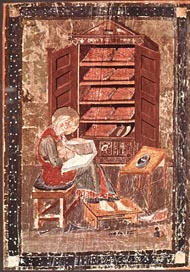Art Home | ARTH Courses | ARTH 212 Assignments
Cassiodorus
The Prophet Ezra from the Codex Amiatinus, made at the monasteries of Wearmouth and Jarrow in the early 8th century. The miniature is probably based on an Italian 6th century miniature of Cassiodorus compiling the Codex Grandior.
Born ca. 480, Flavius Magnus Aurelius Cassiodorus Senator was from a venerable family from southern Italy. Following in his father's footsteps, Cassiodorus dedicated his early career to serving in the administration of Theodoric, the Ostrogothic ruler of Italy. Cassiodorus held positions like quaestor, consul, and the governorship of his native Lucania and Brutii. In 523 Cassiordous was elevated by Theodoric to the position of master of the offices, a position he held until 527. In this position, he had responsibility for the civil service of the Ostrogothic state.
With the conquest of Italy by Justininian, Cassiodorus withdrew from public life. He dedicated the rest of his life to religious affairs. Cassiodorus founded a double monastery: one part for the solitary hermit; the other was dedicated to the communal or cenobitic life. The latter monastery was named Vivarium. Cassiodorus understood the central role education played in the life of the monastery. He layed out his education program in his An Introduction to Divine and Human Readings. Central to Cassiodorus's vision was the integration of Classical thought into the Christian tradition. Following in the tradition of St. Augustine, Cassiodorus emphasized the usefulness of the Classical tradition to Christianity and the understanding of the Bible. Cassiodorus understood the critical role of his monastery in the preservation and dissemination of the great literature of the past, Greek and Latin, pagan as well as Christian. His monks were busy translating Greek texts into Latin and emending and copying texts. At the very core of the life of the monastery was the contemplation of Divine Scriptures:
| Consider, most excellent companions, how wonderful, how agreeable are the ordered words which flow through the Divine Scriptures, the object of ever-increasing desire, the endless sufficiency, the glorious object for which the blessed hunger; an excessive desire to attain this object is not blamed, but extreme eagerness to do so is praised --and justly so, for from this comes the knowledge of things which pertain to eternal salvation and on their account everlasting life is offered to those who believe them and carry out their bidding. |
One of the major projects for Cassiodorus was compiling a version of the Bible. This so-called Codex Grandior was a nine part division of the Old and New Testaments. The titles of the nine books in the cupboard in the background of the Ezra image from the Codex Amiatinus correspond to those enumerated by Cassiodorus in his Codex Grandior.
Further Links:
